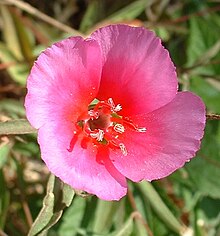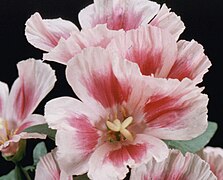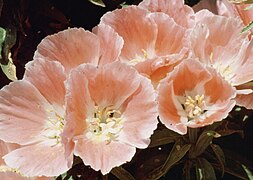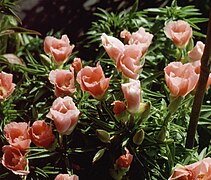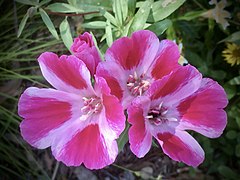
Digitalis purpurea, the foxglove or common foxglove, is a toxic species of flowering plant in the plantain family Plantaginaceae, native to and widespread throughout most of temperate Europe. It has also naturalised in parts of North America and some other temperate regions. The plant is a popular garden subject, with many cultivars available. It is the original source of the heart medicine digoxin. This biennial plant grows as a rosette of leaves in the first year after sowing, before flowering and then dying in the second year. It generally produces enough seeds, however, so that new plants will continue to grow in a garden setting.

Hyacinthus orientalis, the common hyacinth, garden hyacinth or Dutch hyacinth, is a species of flowering plant in the family Asparagaceae, subfamily Scilloideae, native to southwestern Asia, southern and central Turkey, northwestern Syria, Lebanon and northern Israel. It was introduced to Europe in the 16th century. It is widely cultivated everywhere in the temperate world for its strongly fragrant flowers which appear exceptionally early in the season, and frequently forced to flower at Christmas time.

Lavandula stoechas, the Spanish lavender or topped lavender (U.S.) or French lavender (U.K.), is a species of flowering plant in the family Lamiaceae, occurring natively in several Mediterranean countries, including France, Spain, Portugal, Italy, Turkey and Greece.

Cornus kousa is a small deciduous tree 8–12 m (26–39 ft) tall, in the flowering plant family Cornaceae. Common names include kousa, kousa dogwood, Chinese dogwood, Korean dogwood, and Japanese dogwood. Synonyms are Benthamia kousa and Cynoxylon kousa. It is a plant native to East Asia including Korea, China and Japan. Widely cultivated as an ornamental, it is naturalized in New York State.

Lobularia maritima is a species of low-growing flowering plant in the family Brassicaceae. Its common name is sweet alyssum or sweet alison, also commonly referred to as just alyssum.

Dianthus chinensis, commonly known as rainbow pink or China pink is a species of Dianthus native to northern China, Korea, Mongolia, and southeastern Russia. It is a herbaceous perennial plant growing to 30–50 cm tall.

Clarkia is a genus within the flowering plant family Onagraceae. Over 40 species are currently classified in Clarkia; almost all are native to western North America, though one species is native to South America.

Lavandula angustifolia, formerly L. officinalis, is a flowering plant in the family Lamiaceae, native to the Mediterranean. Its common names include lavender, true lavender and English lavender ; also garden lavender, common lavender and narrow-leaved lavender.

Dicentra formosa is a flowering plant with fern-like leaves and an inflorescence of drooping pink, purple, yellow or cream flowers native to the Pacific Coast of North America.

Antirrhinum majus, the common snapdragon, is a species of flowering plant belonging to the genus Antirrhinum. The plant was placed in the family Plantaginaceae following a revision of its prior classical family, Scrophulariaceae.
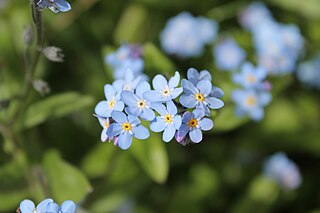
Myosotis sylvatica, the wood forget-me-not or woodland forget-me-not, is a species of flowering plant in the family Boraginaceae, native to Europe. This spring-flowering plant and its cultivars, typically with blue flowers, are the familiar forget-me-nots of gardens.

Cleome houtteana, commonly known as spider flower, spider plant, pink queen, or grandfather's whiskers, is a species of flowering plant in the genus Cleome of the family Cleomaceae, native to southern South America in Argentina, Paraguay, Uruguay, and southeast Brazil. It has also been introduced to South Asia, including the Haor area of Bangladesh and India.

Codiaeum variegatum is a species of plant in the genus Codiaeum, which is a member of the family Euphorbiaceae. It was described by Carl Linnaeus in 1753. It is native to Indonesia, Malaysia, Australia, and the western Pacific Ocean islands, growing in open forests and scrub.

Adenium obesum, more commonly known as a desert rose, is a poisonous species of flowering plant belonging to the tribe Nerieae of the subfamily Apocynoideae of the dogbane family, Apocynaceae. It is native to the Sahel regions south of the Sahara, tropical and subtropical eastern and southern Africa and also the Arabian Peninsula. Other names for the flower include Sabi star, kudu, mock azalea, and impala lily. Adenium obesum is a popular houseplant and bonsai in temperate regions.

Acer davidii, or Père David's maple, is a species of maple in the snakebark maple group. It is native to China, from Jiangsu south to Fujian and Guangdong, and west to southeastern Gansu and Yunnan.
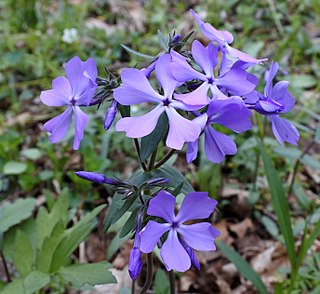
Phlox divaricata, the wild blue phlox, woodland phlox, or wild sweet william, is a species of flowering plant in the family Polemoniaceae, native to forests and fields in eastern North America.

Oxalis triangularis, commonly called false shamrock, is a species of perennial plant in the family Oxalidaceae. It is native to several countries in southern South America. This woodsorrel is typically grown as a houseplant but can be grown outside in USDA climate zones 8a–11, preferably in light shade.
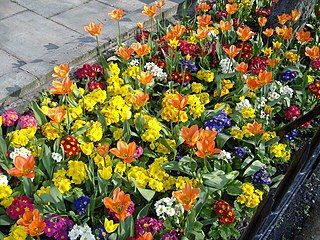
Many types of flowering plants are available to plant in flower gardens or flower beds. The floral industry calls these plants, bedding plants. These fast-growing plants in seasonal flower beds create colourful displays, during spring, summer, fall or winter, depending on the climate. Plants used for bedding are generally annuals, but biennials, tender perennials, and succulents are used.

Iris japonica, commonly known as fringed iris, shaga and butterfly flower, is a native of China and Japan. It is a species in the genus Iris, in the subgenus Limniris and within the Lophiris section. It is a rhizomatous perennial plant, with pale blue, lavender or white flowers with an orange or yellow crest. It is cultivated as an ornamental plant in temperate regions.
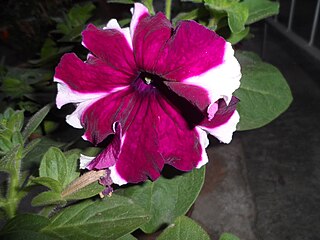
Petunia × atkinsiana is a Petunia plant "nothospecies" (hybrid), which encompasses all hybrid species of petunia between P. axillaris and P. integrifolia. Most of the petunias sold for cultivation in home gardens are this type and belong to this nothospecies.
